Standard [CURRENT]
ASTM D 8114:2025
Standard Test Method for Measurement of Effects of Automotive Engine Oils on Fuel Economy of Passenger Cars and Light-Duty Trucks in Sequence VIE Spark Ignition
- Publication date
- 2025
- Original language
- English
- Pages
- 80
- Publication date
- 2025
- Original language
- English
- Pages
- 80
- DOI
- https://dx.doi.org/10.1520/D8114-25
Product information on this site:
Quick delivery via download or delivery service
Buy securely with a credit card or pay upon receipt of invoice
All transactions are encrypted
Short description
1.1 This test method covers an engine test procedure for the measurement of the effects of automotive engine oils on the fuel economy of passenger cars and light-duty trucks with gross vehicle weight 3856 kg or less. The tests are conducted using a specified spark-ignition engine with a displacement of 3.6 L (General Motors) 4 on a dynamometer test stand. It applies to multi-viscosity oils used in these applications. 1.2 The values stated in SI units are to be regarded as standard. No other units of measurement are included in this standard. 1.2.1 Exceptions- Where there is no direct equivalent such as the units for screw threads, National Pipe threads/diameters, tubing size, and single source supply equipment specifications. Additionally, Brake Specific Fuel Consumption (BSFC) is measured in kilogram per kilowatt hour. 1.3 This test method is arranged as follows: Subject Section Introduction Scope 1 Referenced Documents 2 Terminology 3 Summary of Test Method 4 Significance and Use 5 Apparatus 6 General 6.1 Test Engine Configuration 6.2 Laboratory Ambient Conditions 6.3 Engine Speed and Torque Control 6.4 Dynamometer 6.4.1 Dynamometer Torque 6.4.2 Engine Cooling System 6.5 External Oil System 6.6 Fuel System 6.7 Fuel Flow Measurement 6.7.2 Fuel Temperature and Pressure Control to the Fuel Flow Meter 6.7.3 Fuel Temperature and Pressure Control to Engine Fuel Rail 6.7.4 Fuel Supply Pumps 6.7.5 Fuel Filtering 6.7.6 Engine Intake Air Supply 6.8 Intake Air Humidity 6.8.1 Intake Air Filtration 6.8.2 Intake Air Pressure Relief 6.8.3 Temperature Measurement 6.9 Thermocouple Location 6.9.5 AFR Determination 6.10 Exhaust and Exhaust Back Pressure Systems 6.11 Exhaust Manifolds 6.11.1 Laboratory Exhaust System 6.11.2 Exhaust Back Pressure 6.11.3 Pressure Measurement and Pressure Sensor Locations 6.12 Engine Oil 6.12.2 Fuel to Fuel Flow Meter 6.12.3 Fuel to Engine Fuel Rail 6.12.4 Exhaust Back Pressure 6.12.5 Intake Air 6.12.6 Intake Manifold Vacuum/Absolute Pressure 6.12.7 Coolant Flow Differential Pressure 6.12.8 Crankcase Pressure 6.12.9 Engine Hardware and Related Apparatus 6.13 Test Engine Configuration 6.13.1 ECU (Power Control Module) 6.13.2 Thermostat Block-Off Adapter Plate 6.13.3 Wiring Harness 6.13.4 Thermostat Block-Off Plate 6.13.5 Oil Filter Adapter Plate 6.13.6 Modified Throttle Body Assembly 6.13.7 Fuel Rail 6.13.8 Miscellaneous Apparatus Related to Engine Operation ...
ICS
75.100
DOI
https://dx.doi.org/10.1520/D8114-25
Also available in
Loading recommended items...
Loading recommended items...
Loading recommended items...
Loading recommended items...

